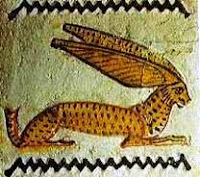The Anglo-Saxon Goddess of sunrise and of spring was known as Eostra or Eastre and her sacred month was Eastremonath, the Moon of Eostre. One of the largest fertility festivals of the ancient calendar, Eostra, falls on the spring equinox when day and night are in equal balance and life has returned in profusion.
Like all the church's "moveable feasts," Easter shows it's pagan origin in a dating system based on the old lunar calendar. The modern Christian Easter Festival derived from the original name of the month. It is always the first Sun's Day after the first full moon after the Spring Equinox. Formerly the full moon represented the "pregnant" phrase of Eostre passing into the fertile season. The Christian festival wasn't called Easter until the Goddess's name was given to it in the late Middle Ages. The Irish observed Easter on a different date from that of the Roman church, probably the original date of the festival of Eostre, until the Roman calendar was imposed on us in 632 A.D.
Eostra and the Hare
.
The hare was endowed with similar earth-bound powers. It was believed that Eostre changed into a hare at the full Moon.
Man
has for centuries respected, even feared the hare because of its perceived
powers of solitude and remoteness. Active at night, symbolic of the intuitive,
and the fickleness of the Moon, the hare was an emblem of unpredictability.
The transmigration of the soul is clearly seen in Celtic lore such as this.
Throughout the world, there are long-spoken tales of hares; from the Americas to the Far East , from Africa to Europe , the hare is embedded in the folk myths of our ancestors.
It is associated in mythology with the Moon, the celestial skies and the Sun, with fertility, the dawn, cunning and bravery. There is evidence of hare mythology in ancient pottery, coins, seals, and hieroglyphics and in oral history. (In

 The hieroglyphic 'Wn', depicting a hare on top
of a single blue-green ripple, means 'to exist'.
The hieroglyphic 'Wn', depicting a hare on top
of a single blue-green ripple, means 'to exist'. Many European gods and goddesses are associated with hares:
·
Hittavainen (or Hittauanin) is the
Karelian god of hares and hare-hunting
·
The hare is often depicted as a
companion to Cupid and as an attribute of Aphrodite/Venus, being associated
with fertility and love
·
Holda (or Herke, Harfer) of Teutonic
mythology, was followed by a train of hares carrying torches
·
The Norse goddess Freyja had hare
attendants
·
In Britain
·
The hare is associated with the Celtic
goddess Cerridwen
·
Kaltes is a Moon goddess venerated by
the Ugric people of western Siberia . She was a
shape-shifter and often manifested as a hare
In earliest times
killing and eating the hare was taboo. In 
This is in definitely one of my favourite blog posts of yours. I love it!Such a wonderful place to visit. All the pics are amazing. I also want to go there and i think first i need to learn the language so that i can do fully enjoy there. Thanks for sharing us.
ReplyDeletePlanning a trip to portugal